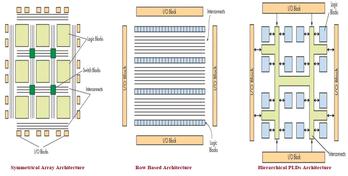FPGA vs eFPGA: Key Differences Explained
Advertisement
This article compares FPGA and eFPGA, highlighting the key differences between them.
The full form of FPGA is Field Programmable Gate Array, while eFPGA stands for Embedded FPGA.
FPGA | Field Programmable Gate Array
 Figure-1: FPGA chip
Figure-1: FPGA chip
The FPGA Architecture consists of the following key components:
- Configurable Logic Block (CLB): Contains digital logic, inputs, and outputs. It implements the user-defined logic.
- Interconnects: Provides routing between the logic blocks to implement the desired user logic.
- Switch Matrix: Facilitates switching between interconnects based on the programmed logic.
- Input/Output pads: Used for external communication with the outside world.
 Figure-2: FPGA Architecture
Figure-2: FPGA Architecture
A Logic Block typically consists of:
- LUT (Look-Up Table): Implements combinational logic functions.
- Register (D flip-flop): Stores the output of the LUT.
- MUX (Multiplexer): Used for selection logic.
Xilinx and Altera are well-known manufacturers of FPGA ICs.
eFPGA | Embedded Field Programmable Gate Array
 Figure-3: eFPGA on SoC or ASIC
Figure-3: eFPGA on SoC or ASIC
- eFPGA is available as an IP core that can be integrated into an ASIC or SoC to provide programmable logic capabilities.
- Unlike traditional FPGA chips, components like GPIOs, SERDES, and PHYs are generally not integrated on the SoC or ASIC with the eFPGA.
- With eFPGAs, you have the flexibility to define the quantity of LUTs, embedded memory, registers, and DSP blocks according to your needs.
- Controlling the aspect ratio and the number of I/O ports is also easily achievable.
- This allows for a flexible trade-off between power consumption and performance.
- Figure-3 illustrates a reconfigurable RTL, which represents the FPGA core. Other SoC components such as DSP, CPU, SRAM, and hardwired RTL are also depicted.
- The eFPGA IP can be licensed from various vendors and integrated into an ASIC or SoC.
Benefits of using eFPGA architecture over FPGA are as follows:
- eFPGA can be customized post-production with minimal expenses, unlike traditional FPGAs.
- eFPGA eliminates the need to change the RTL design post-production or re-manufacture chips.
This inherent flexibility gives eFPGAs an advantage over traditional FPGAs in many applications.
Difference between FPGA and eFPGA
The following table highlights the key architectural differences between FPGA and eFPGA:
| Specifications | Traditional FPGA | eFPGA |
|---|---|---|
| I/O interconnect | Through packages such as PCIe, SERDES, etc. | Within SoC or ASIC designs |
| GPIOs | Up to approx. 400 | Up to approx. 10K |
| Clocks | Can be generated using dedicated PLLs on chip. | Can be generated within SoC/ASIC |
| Memory | Fixed amount | Customised |
| Hard blocks | Fixed vendor hard blocks | Customer-defined hard blocks or menta hard blocks |
| Foundry | Fixed | At customer choice |
| Temperature range | Need to select appropriate FPGAs from catalogue as per temperature requirements. | At customer choice. |
| Size (Logic Cells) | Different vendors manufacture different sizes. | Available from 12K to 200K sizes |
Advertisement
 RF
RF

